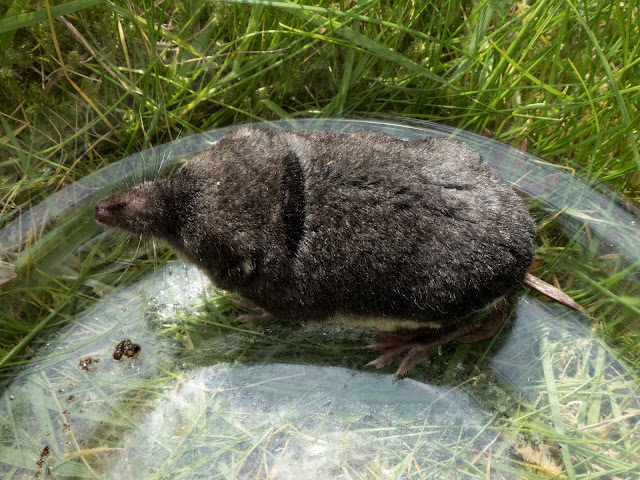It is obviously a shrew but very different in appearance from the common shrew I had seen before. It is dark with white ear tufts, white spots behind the eyes and whitish feet. I was fairly sure it was a water shrew but I couldn't convince anyone I showed the video to.
So I decided to try to catch it. I set a Longworth trap and on the first day I caught two bank voles and a wood mouse (more on this another time). On the second day I had only a short time before going away for a few days but when I went to collect the trap there was something in it. And when I opened the trap there was my shrew.
It is almost black with white underneath, white ear tufts and small white spots behind the eyes. It has white hairy feet and is very much a water shrew (Neomys fodiens). I put it in a plastic bag to weigh it and try to measure it and photograph it but it immediately tried to bite its way out.
So I put it in a large glass jug, the only thing I could find immediately that would keep it safe. The shrew ran round and round for a while but soon settled down when it realised it couldn't escape. It wasn't the easiest thing to photograph it in, or the easiest subject, but here are a few photos.
And a short video.
Then I put it back at the entrance to the stone. The shrew gave me a cold hard stare before it turned and disappeared, perhaps hoping to remind me that it has a venomous bite and will get me next time!
I don't plan to catch the shrew again but I shall keep an eye on it with the trail camera. When I checked again yesterday it was still there but looking a bit more hesitant, perhaps fearing another trap. It is interesting that although it is a carnivore it takes sunflower seeds, even though casters (blowfly pupae) are on offer.
This was an extraordinary find in a pile of stones in dry woodland about 300-400m from the nearest watercourse. However, the Mammal Society website says "Occasionally they are found far from water in rough grasslands, scrub, woodlands and hedgerows, usually as young are dispersing". This one weighed 13g which is towards the lower end of the weight range and is probably young. I couldn't get accurate measurements but judging from the ruler on the photos its body length is probably about 65mm and its tail about 45mm which also puts it towards the lower end of the range for water shrews.
The Mammal Society website says that mammals are some of the most under recorded species in Britain, perhaps surprising considering some of them are fairly obvious. I expect, however, that mammal observers are fewer than bird and insect observers. So I submitted my record, which turns out to be only the second one for Northumberland on their system (the red dot being mine).
The Mammal Society carried out a National Water Shrew Survey in 2004-2005 and you can read the report here.
About one third of my garden is left as a completely wild wood (only ⅓ acre) for anything that wants to live there. Other things I have seen in the past, but not photographed, include weasel, stoat, woodcock and field vole. I don't know what else is lurking in there but I'll be using the trail cameras a lot more to try to find out.










No comments:
Post a Comment